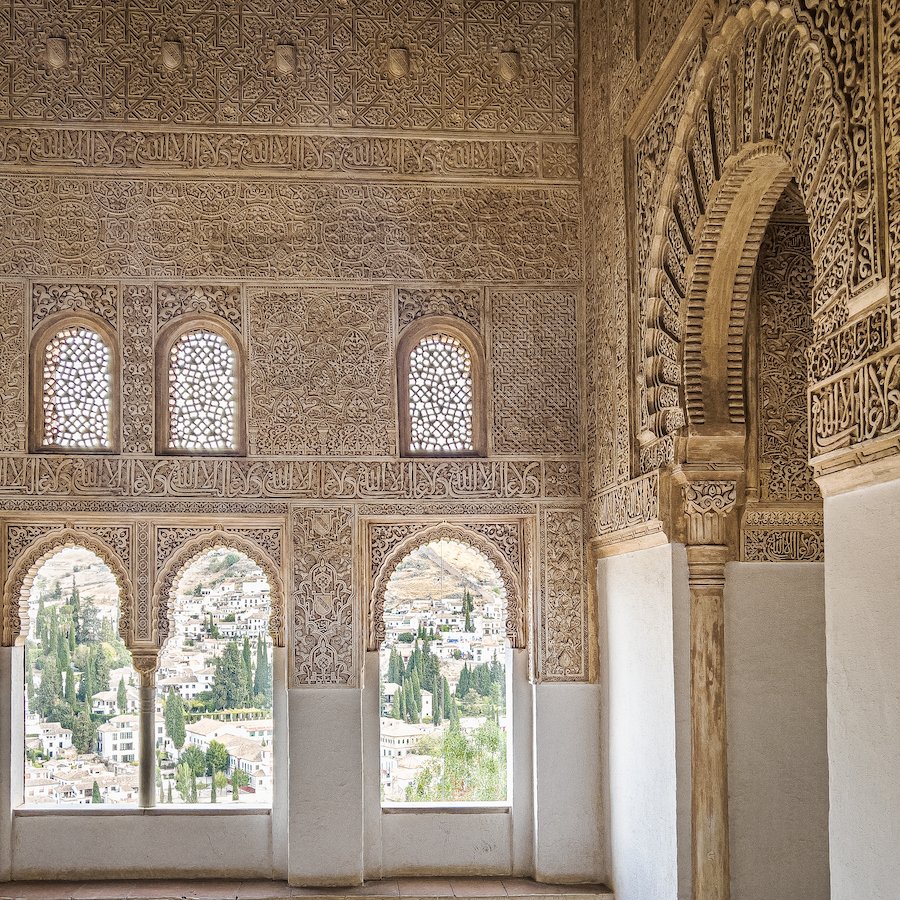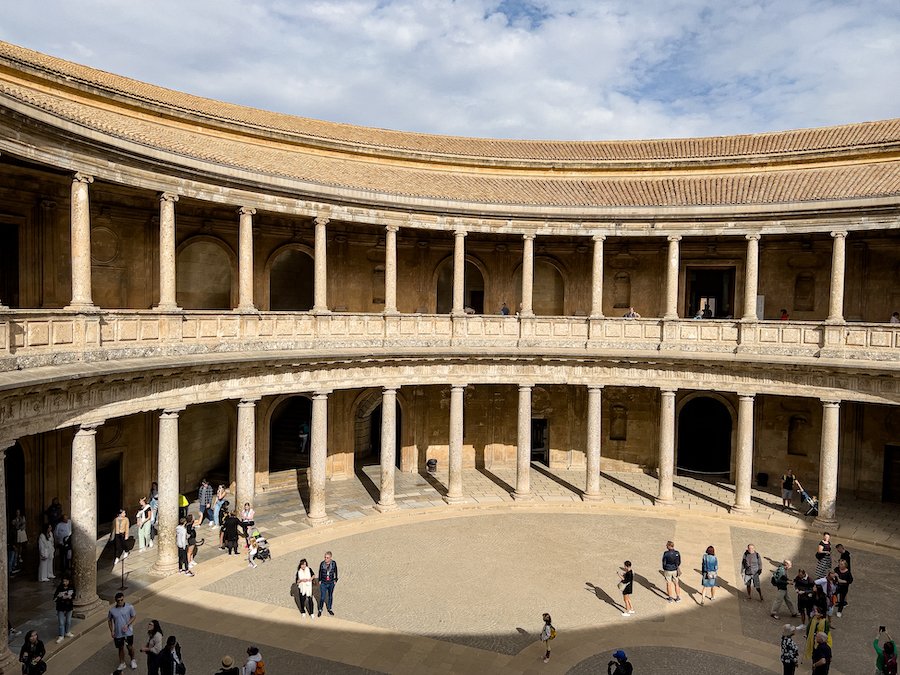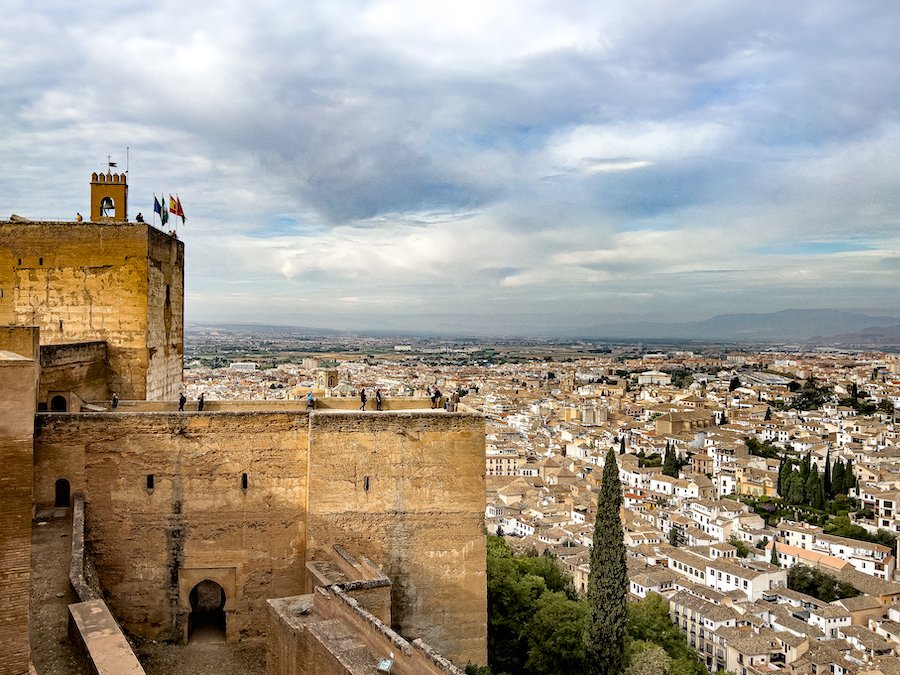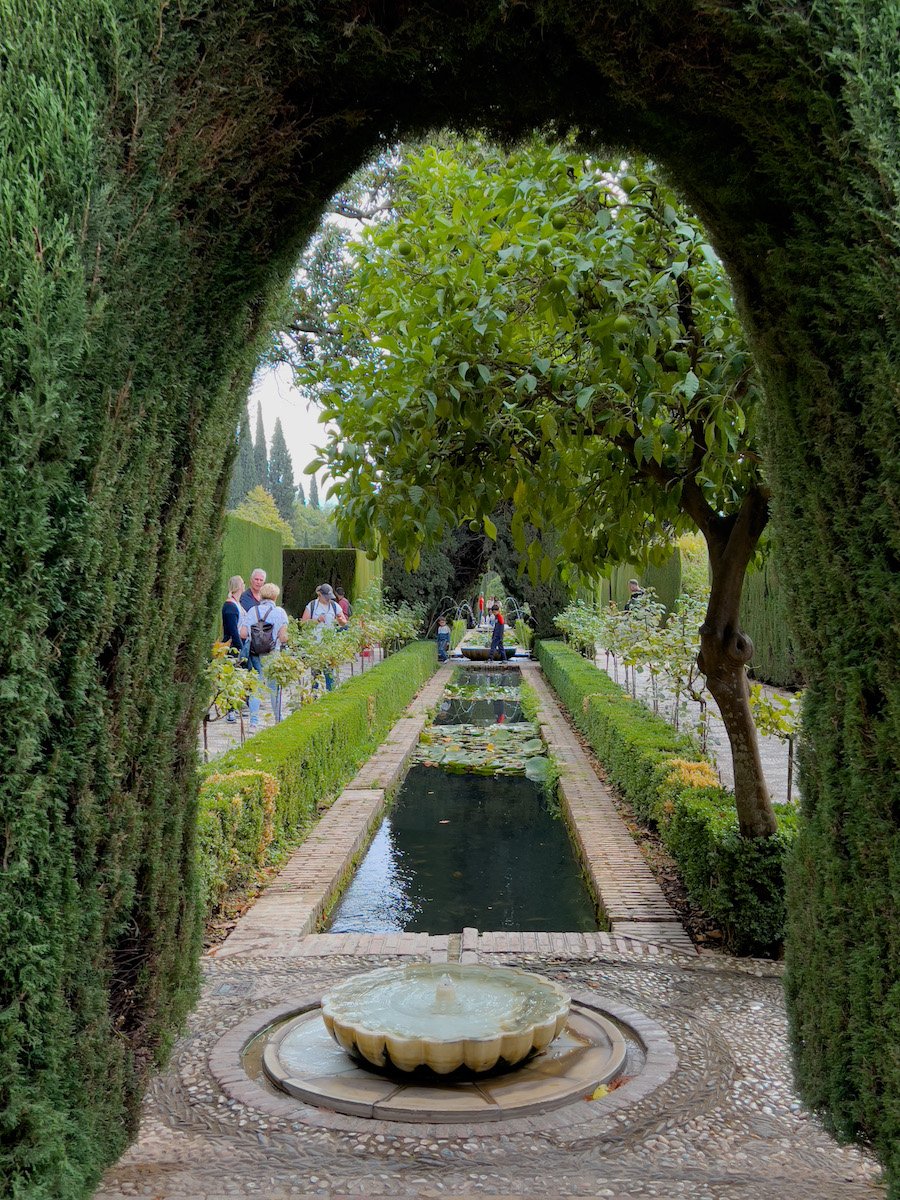How to Deep Travel at Granada’s Magnificent Alhambra
Nov 2, 2023 instagram post reads “The magic of the Alhambra at sunset. I’m excited to wake up very early tomorrow morning to walk up and explore inside!”
Short on time? Pin it here!
-
Deep Travel Overwhelm
The Alhambra Forest
The Sultan’s Palace
The Oldest Palace
The Palace of Charles V
The Alhambra “the red” Fortress
The Gardens of the Alhambra
Deep Travel through Layers of History
How to Visit the Alhambra
The Alhambra is one of the most visited tourist destinations in Spain. Yet in spite of its crowds and busyness, it can also offer a fantastic opportunity for deep travel. You will have to tolerate people trying to get the perfect selfie or instagrammable photo, but with a little effort to learn some history, eat local food, connect with people, and marvel at different cultures, the Alhambra in Granada has the perfect ingredients for a deep travel experience. Really, experiencing any culturally historic place with intention, like the Alhambra, will result in a more meaningful visit.
Deep travel can be defined as a feeling of interconnectedness and heightened experience. I often use the term travel bliss for deep travel, and I definitely felt my travel bliss at the Alhambra.
Deep Travel Overwhelm
During our slow travel journey through Andalucia, Spain, I posted photos on instagram daily as a way to share my journey and build in some daily reflection. Instagram became my travel journal with snippets of the experiences I was having and the lessons about myself I was discovering. On the day we went to the Alhambra in Granada I was unable to share anything about our visit. I admitted in my post, “I was going to share about our day at the Alhambra today…but to be honest I’m still overwhelmed by this spectacularly beautiful and expansive “city”. I am mentally processing the experience!” It took me several months to dive back in, review my photos, and finish reflecting on the visit.
My husband and I had countless amazing experiences travelling across Spain but the Alhambra was one that, for some reason, found a footing in my heart. Maybe because it combined so much of the Spain that I was falling in love with in one location. Maybe because I immediately wanted to return as there was so much (too much) to absorb in a single day-long visit. Maybe because I am a romantic history buff who has a soft spot for the underdog (the Moors in this case) and am easily awed by incredible art and architecture. Probably all of the above!
I share my experience to be helpful to anyone planning a visit there or, really, to any travel destination with a hope to evoke a deeper connection and richer memories.
The Alhambra Forest
Our visit began with a very early morning climb to the entrance gate. Seeing the sun rising over the rolling hills sprinkled with whitewashed houses was spectacular. We purchased 830 am timed tickets to see Nasrid Palace which included entrance to the Alcazaba and Generalife. An early arrival is highly recommended given the number of visitors, so stay one step ahead of the crowds by showing up early! And don’t forget your passport as it is required for entrance into many parts of the Alhambra.
Instead of a bus, we chose to walk. Despite getting a bit anxious about arriving on time and starting the day a bit sweaty, I would do it again. It’s a long slow incline with the occasional steep section but it is very manageable. It only took 30 minutes, I didn’t get lost, and I wasn’t late! For my next deep travel visit I will slow down and enjoy the journey so much more by taking in the sights and sounds of the streets and forest leading to the Alhambra gate.
Gate of the Pomegranates
Walking up the narrow, twisty, cobbled streets of the Albaicín brought us to Puerta de las Granadas - Gate of the Pomegranates. This arched gateway was added sometime around 1536 by King Charles V for his marriage to Isabel of Portugal. It adds a distinct Christian layer to the Alhambra’s beauty and story, and foreshadowed other changes to follow in a post-Moorish, Christian occupation.
Through this first beautiful gate, enter the Alhambra forest keeping left towards the Royal Palace. The stillness of the morning is accentuated by the smell of fresh garden earth, the sound of water fountains burbling, and the internal anticipation of the beauty that awaits! And you know it’s going to be special at the first site of the original Alhambra entrance built in 1348! Soak in the horseshoe shaped entrance in true Moorish architectural style and the intricate stone carving of the Justice Tower.
According to history, King Mohammed ben Al-Hamar (1238-1273) first made his royal residence within the Alhambra walls. The area had been used as a fortress for 300 years prior but with the Sultan things became magical!
There were 23 Arabic emirs or rulers of Granada from 1230 by King Muhammad the first until 1492 (the same year Columbus sailed the ocean blue) when Muhammad the 12th surrendered all lands to Christian Queen Isabella and King Ferdinand of Castile.
Read more about this epic time in history from conquering Queen Isabella’s point of view in the novel The Queen’s Vow.
Breathtaking Nasrid Palace
The Sultan’s Palace
Nasrid Palace is the first stop after passing through the ticket entrance. Pre-bought, timed tickets and passports are essential for a smooth visit. What struck me as I entered the palace was the intricacy of the ceramic, plasterwork and wood that blanketed every surface with rich patterns steeped in Arabic symbolism. Every nook and cranny is decorated no matter the size of the space. The rooms are empty but you can use your imagination to visualize the rugs, pillows, curtains and furniture along with the sweet smell of mint tea!
After many visits to incredible gothic cathedrals and museums full of gothic, renaissance, and baroque art, Nasrid Palace shakes the senses by being so different! Unlike Christian churches and palaces that overflow with gold, ornate paintings, statues, and rich colour, the Muslim religion bans the representation of figures in art and architecture. Instead you see exquisite patterns and symmetry, Arabic calligraphy of poems, and breathtaking stalactite masterpieces that cover the walls and ceilings.
Google Nasrid Palace for photo images and you will likely see the Court of the Lions. It is a stunning open gallery supported by 124 white marble pillars surrounding a fountain with twelve lion sculptures. The marble fountain basin is a prime example of Muslim carving and shows off their ingenuity in water engineering. The Court of the Lions was built by the fifth Mohammed king in 1362 AD.
The Oldest Palace
After emerging from the almost indescribable Nasrid Palace, you enter a beautiful garden area overlooking the city of Granada. Along one wall is another amazing building called the Partal Palace with 5 arches overlooking a reflecting pool.
The pools are so clean and still, the reflections are incredible.
This palace was likely built by the first sultan’s predecessor in the late 1200’s making it the oldest palace within the walls. Hundreds of years later it became a private residence and was finally ceded to the Spanish government in 1891. Imagine living here!
The Palace of Charles V
The Palace of Charles V is yet another palace within the walls of the Alhambra. He built it smack in the middle of the Alhambra to symbolize the Christian triumph over the Moors who ruled here for almost 8 centuries. At first glance it is a really big, boxy building. (I apparently didn’t take a photo of the exterior). It is elegant with interesting round windows. But then….enter the building and feel gobsmacked (well, I was) that it is round inside!
Charles was grandson to Queen Isabella and King Ferdinand. He began building his palace 35 years after the Moors were expelled in 1492. Interestingly, it didn’t get finished. As you walk around you’ll see it has two levels but it was designed to have three. The construction was abandoned with neither third floor nor roof in the 1600s and used, instead, for storage (!!). A wonderful building to explore including 2 museums and an art-quality gift shop.
Inside the Palace of charles V. I found the stone used for the columns fascinating. They are “conglomerate” stone which consists of multiple fragments so it looks mottled. It is striking.
The Alhambra “the red” Fortress
After passing through a second ticketed area where you need to show your passport, enter into the fortress. This part of the Alhambra complex is all about military defenses. No wonder Granada was the last stronghold of the Moors in Spain. The strategic location is stellar! On a clear day you can see the Sierra Nevada mountains and the expansive vista would ensure you were never surprised by an attack!
It is incredible to walk the Alhambra Fortress walls and climb the towers and feel the gratitude of looking out at peaceful times in Spain!
The Gardens of the Alhambra
Gardens in Generalife
The Alhambra is essentially a city covering 26 acres and there are gardens EVERYWHERE! For those who love of gardens, you won’t be disappointed! The 14th century Arab-designed gardens are made for deep travellers as they represent the longing for paradise and are intentional about pleasing all five senses. The colours are varied, of course, but there is also intention in the layout which takes advantage of light, the smell of the plants, and the constant murmur of water. I visited in November and I can’t tell you how many times I said “Imagine this place in the spring!” Google tells me that there are 80,000 specimens planted, 50,000 of which are grown in the Alhambra’s own greenhouses.
At one end of the complex is the Generalife area (pronounced Gen-er-alif-ay). The final place to show your passport for entry. Imagine three terraced gardens with meandering paths leading to the Sultan’s summer get-away! Majestic Cypress trees, sculptured hedges making little privacy rooms, garden beds showing off a riot of colour, and flowing water courtesy of ingenious and artistic 14th century irrigation methods. In season it would have been even more stunning and I think I could have endured the significant seasonal crowds to spend an entire weekend there.
Deep Travel through Layers of History
The Moors ruled the Iberian peninsula for over 700 years. Christian monarchs fought them back and eventually in the late 1400’s Granada was their very last stronghold. Queen Isabella and King Ferdinand were successful in finally defeating the Moors and expelled them from Spain.There is a legend that Mohammed the 12th, the last Sultan of Granada, eventually surrendered the keys of the city to the Catholic monarchs at Puerta de los Siete Suelos (Door of the Tower of Seven Floors). The sultan made a deal with the Christian monarchs that no one be allowed to pass through the gate after he left. Apparently his request was respected and the gate was walled up.
Another story of Mohammed the 12th is famously told that he was in tears as he surrendered. His mother has been quoted to have snapped: “You cry like a woman for what you haven’t been able to defend as a man.” She was obviously, and perhaps understandably, very bitter to be forced to leave this paradise!
Multiple Spanish monarchs adapted the palaces for their own use and it was eventually invaded in the 18th century by Napoleon who wanted to blow it up. Legend says that a wounded soldier left behind diffused the bomb meant to destroy everything. (Phew!)
After this, the Alhambra was completely abandoned. Some say we have American author Washington Irving to thank for reviving interest in the site. After completing a biography of Christopher Columbus in 1828, Irving traveled to Granada and arranged access to the abandoned area. There he brought it to life in his book Tales of Alhambra, recreating what life must have been like through a collection of stories and essays. After his book was published, the palace began to be restored and maintained, and has been a UNESCO World Heritage Site since 1984, visited by 3 million visitors a year. That’s over 8000 people every day!
“Perhaps there never was a monument more characteristic of an age and people than the Alhambra; a rugged fortress without, a voluptuous palace within; war frowning from its battlements; poetry breathing throughout the fairy architecture of its halls.”
The Sultan’s summer place.
How to Visit The Alhambra
I researched how to visit this incredible place by reading and following every word of Karen Rosenblum’s Spain Less Traveled. Karen is an American who now calls Spain her home and her Spain travel information is excellent. Make sure to read her tips of what not to do! One great piece of advice from Karen is to stop for something to eat at the Parador cafe. We shared the beautiful patio with only a few other people overlooking the rolling hills - it was a great suggestion.
This article (click here) was invaluable to me in preparing to visit the Alhambra. Karen also offers 1:1 planning sessions which a friend of mine used and was thrilled with the customized planning support. There are so many options to customize how you travel - DIY it, or semi-DIY it by finding day tours and experiences that match your interests.
Beyond the logistics and history, deep travel to places of such historical significance requires us to manage our emotions and to build in time for reflection. Consider:
Your expectations - do your own research and don’t get stuck on the curated images you see on social media. Your interests, your insights, and your pace should dictate your trip to the Alhambra, not just what others have posted online - including me.
The crowds - tap into your ability to be patient. Find a corner and soak things in and let people pass rather than get pushed along by the crowds. Start earlier in the day and keep your schedule flexible so you aren’t pressed for time.
The overload of beauty - allow yourself to take in as much as your brain will allow and consider returning. It is hard to grasp and appreciate the vastness and connectedness of the various parts of the Alhambra and it warrants revisiting or retracing to put it all into greater context. I left the Alhambra wishing I had also included an evening visit for both a night perspective and an opportunity to see things a second time.
Different perspectives - see the Alhambra during both day and night, from both inside and outside the palace grounds and walls. We also enjoyed a walking tour of Granada that took us to an elevated lookout in the Sacramonte from which we looked directly across at the Alhambra while the sun set. Had it not been late in the day, we could have continued up the hills towards ancient city walls and the lands from which the Alhambra’s aqueducts brought water to the city.
Connecting the history with the current culture - wander the Albaicín after your visit to the Alhambra and enjoy the market and restaurants serving delicious arabic food. Talk with people when you can. We had a charming chat with a young boy running his father’s store. Use your time in Granada as an opportunity to consider how the history of the place has influenced people still living there today.
More deep travel tips for the Alhambra? Please share in the comments along with any comments and questions!











